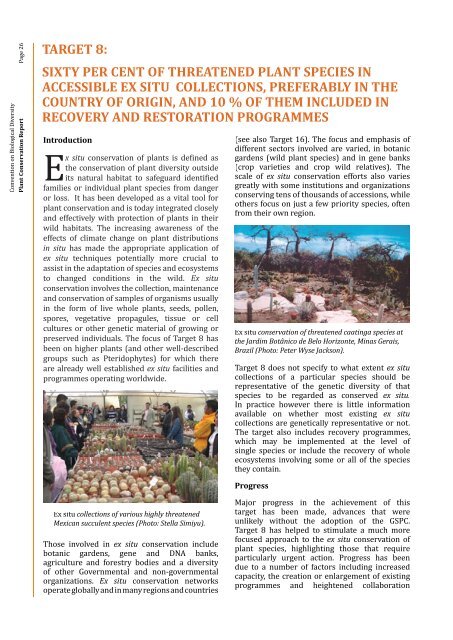Convention on Biological DiversityPlant Conservation Report Page 26TARGET 8:SIXTY PER CENT OF THREATENED PLANT SPECIES INACCESSIBLE EX SITU COLLECTIONS, PREFERABLY IN THECOUNTRY OF ORIGIN, AND 10 % OF THEM INCLUDED INRECOVERY AND RESTORATION PROGRAMMESIntroductionEx situ <strong>conservation</strong> of <strong>plant</strong>s is deined as<strong>the</strong> <strong>conservation</strong> of <strong>plant</strong> diversity outsideits natural habitat to safeguard identiiedfamilies or individual <strong>plant</strong> species <strong>from</strong> dangeror loss. It has been developed as a vital tool <strong>for</strong><strong>plant</strong> <strong>conservation</strong> and is today integrated closelyand effectively with protection of <strong>plant</strong>s in <strong>the</strong>irwild habitats. The increasing awareness of <strong>the</strong>effects of climate change on <strong>plant</strong> distributionsin situ has made <strong>the</strong> appropriate application ofex situ techniques potentially more crucial toassist in <strong>the</strong> adaptation of species and ecosystemsto changed conditions in <strong>the</strong> wild. Ex situ<strong>conservation</strong> involves <strong>the</strong> collection, maintenanceand <strong>conservation</strong> of samples of organisms usuallyin <strong>the</strong> <strong>for</strong>m of live whole <strong>plant</strong>s, seeds, pollen,spores, vegetative propagules, tissue or cellcultures or o<strong>the</strong>r genetic material of growing orpreserved individuals. The focus of Target 8 hasbeen on higher <strong>plant</strong>s (and o<strong>the</strong>r well-describedgroups such as Pteridophytes) <strong>for</strong> which <strong>the</strong>reare already well established ex situ facilities andprogrammes operating worldwide.(see also Target 16). The focus and emphasis ofdifferent sectors involved are varied, in botanicgardens (wild <strong>plant</strong> species) and in gene banks(crop varieties and crop wild relatives). Thescale of ex situ <strong>conservation</strong> ef<strong>for</strong>ts also variesgreatly with some institutions and organizationsconserving tens of thousands of accessions, whileo<strong>the</strong>rs focus on just a few priority species, often<strong>from</strong> <strong>the</strong>ir own region.Ex situ <strong>conservation</strong> of threatened caatinga species at<strong>the</strong> Jardim Botânico de Belo Horizonte, Minas Gerais,Brazil (Photo: Peter Wyse Jackson).Target 8 does not specify to what extent ex situcollections of a particular species should berepresentative of <strong>the</strong> genetic diversity of thatspecies to be regarded as conserved ex situ.In practice however <strong>the</strong>re is little in<strong>for</strong>mationavailable on whe<strong>the</strong>r most existing ex situcollections are genetically representative or not.The target also includes recovery programmes,which may be implemented at <strong>the</strong> level ofsingle species or include <strong>the</strong> recovery of wholeecosystems involving some or all of <strong>the</strong> species<strong>the</strong>y contain.ProgressEx situ collections of various highly threatenedMexican succulent species (Photo: Stella Simiyu).Those involved in ex situ <strong>conservation</strong> includebotanic gardens, gene and DNA banks,agriculture and <strong>for</strong>estry bodies and a diversityof o<strong>the</strong>r Governmental and non-governmentalorganizations. Ex situ <strong>conservation</strong> networksoperate <strong>global</strong>ly and in many regions and countriesMajor progress in <strong>the</strong> achievement of thistarget has been made, advances that wereunlikely without <strong>the</strong> adoption of <strong>the</strong> GSPC.Target 8 has helped to stimulate a much morefocused approach to <strong>the</strong> ex situ <strong>conservation</strong> of<strong>plant</strong> species, highlighting those that requireparticularly urgent action. Progress has beendue to a number of factors including increasedcapacity, <strong>the</strong> creation or enlargement of existingprogrammes and heightened collaboration
No of taxa and no. of insitutions providing datato BGCI Plantsearch database since 20022000001800001600001400001200001000008000060000400002002 2003 2004 2005 2006 2007 2008700650600550500450400350300250200No of taxaNo of institutionsbetween ex situ practitioners. This has included<strong>the</strong> establishment or re-development of manybotanic gardens where native <strong>plant</strong> <strong>conservation</strong>is a priority.The Millennium Seed Bank Project, initiated by<strong>the</strong> Royal Botanic Gardens Kew and its partnersworldwide, now includes 37,000 accessionsof 20,000 <strong>plant</strong> species, mainly <strong>from</strong> drylands.Ano<strong>the</strong>r important initiative is <strong>the</strong> creation of<strong>the</strong> Global Crop Diversity Trust which has madesigniicant progress towards its $260m endowmenttarget to fund <strong>the</strong> effective <strong>conservation</strong> of <strong>the</strong>biological basis of all agriculture.When <strong>the</strong> GSPC was adopted it was estimatedthat 10% to 20% of known <strong>global</strong>ly threatenedspecies were already included in ex situ<strong>conservation</strong>, and about 2% included in recoveryprogrammes. In response to Target 8 a new<strong>global</strong> <strong>plant</strong> search mechanism and database wasestablished by Botanic Gardens ConservationInternational involving botanic gardensworldwide to monitor <strong>the</strong> achievement of <strong>the</strong>target. At <strong>the</strong> end of 2007 it was estimated that30% to 40% of <strong>global</strong>ly threatened <strong>plant</strong> specieswere included in ex situ <strong>conservation</strong> and about5% in recovery programmes. Good progresshas been made in linking ex situ <strong>conservation</strong>to <strong>the</strong> in situ management of <strong>plant</strong> diversity,particularly in helping to deine priorities <strong>for</strong>ex situ programmes and to provide material <strong>for</strong>research in <strong>conservation</strong> biology and recoveryand re-introductions.Ex situ techniques and technologies have alsosigniicantly advanced. Particular progresshas been made in advancing <strong>the</strong> geneticcharacterization of ex situ collections as well asstorage methodologies, such as cryo-preservation,ultra-dry seed storage and in vitro culture.Particular emphasis has <strong>the</strong>reby been placed oncrop <strong>plant</strong>s and <strong>the</strong>ir relatives.FutureThe achievement of this target remains a majorchallenge but never<strong>the</strong>less feasible by 2010.Ensuring <strong>the</strong> adequate genetic representation ofENSCONET coordinates seed <strong>conservation</strong>activities of wild <strong>plant</strong>s within Europe. Thenetwork involves 24 institutions in 17 countries,working jointly on seed preservation <strong>for</strong> <strong>the</strong>future, to enhance <strong>the</strong> study, in<strong>for</strong>mationand research on seed biology with <strong>the</strong> aimof exchanging experiences, protocols andfacilities to optimize seed <strong>conservation</strong>practices. The network has linked a powerfulgroup and diversity of institutions to targetseed <strong>conservation</strong> needs <strong>for</strong> European wild<strong>plant</strong>s <strong>for</strong> <strong>the</strong> first time. www.ensconet.comex situ collections will be dependent on bettercharacterization of existing collections andimplementation of comprehensive samplingprotocols. More integration of <strong>the</strong> activitiesundertaken by botanic gardens and gene banksis needed to ensure that shared priorities canbe developed, and experiences, resources andtechnologies shared. There are still serious gapsin capacity <strong>for</strong> ex situ <strong>conservation</strong>, especially inAfrica, parts of Asia, <strong>the</strong> Caribbean, Latin Americaand <strong>the</strong> Middle East, where existing institutionsinvolved in ex situ <strong>conservation</strong> are often poorlyresourced. An analysis of <strong>the</strong> extent to which ex situcollections are held within <strong>the</strong> country of originneeds to be undertaken. Progress in identifying<strong>conservation</strong> priorities <strong>for</strong> this target have beenhindered by <strong>the</strong> lack of data on <strong>the</strong> <strong>conservation</strong>status of many species (Target 2) as well as <strong>the</strong>deinition of threatened species, compromisingef<strong>for</strong>ts to ensure that capacity can be directedtowards <strong>the</strong> <strong>conservation</strong> of species of greatestimmediate concern. In <strong>the</strong> absence of <strong>global</strong>data, priorities have often been determined withreference to national lists of rare or threatenedspecies. While many recovery programmes havefocused on critically endangered species, <strong>the</strong>reis a need <strong>for</strong> more recovery and restorationprogrammes that include species of actual orpotential economic concern (medicinal <strong>plant</strong>s,crop wild relatives etc). The impacts of climatechange on <strong>conservation</strong> of species in <strong>the</strong> wild willmake effective ex situ <strong>conservation</strong> even moreimportant than ever be<strong>for</strong>e.Plant Conservation ReportPage 27 Convention on Biological Diversity
















